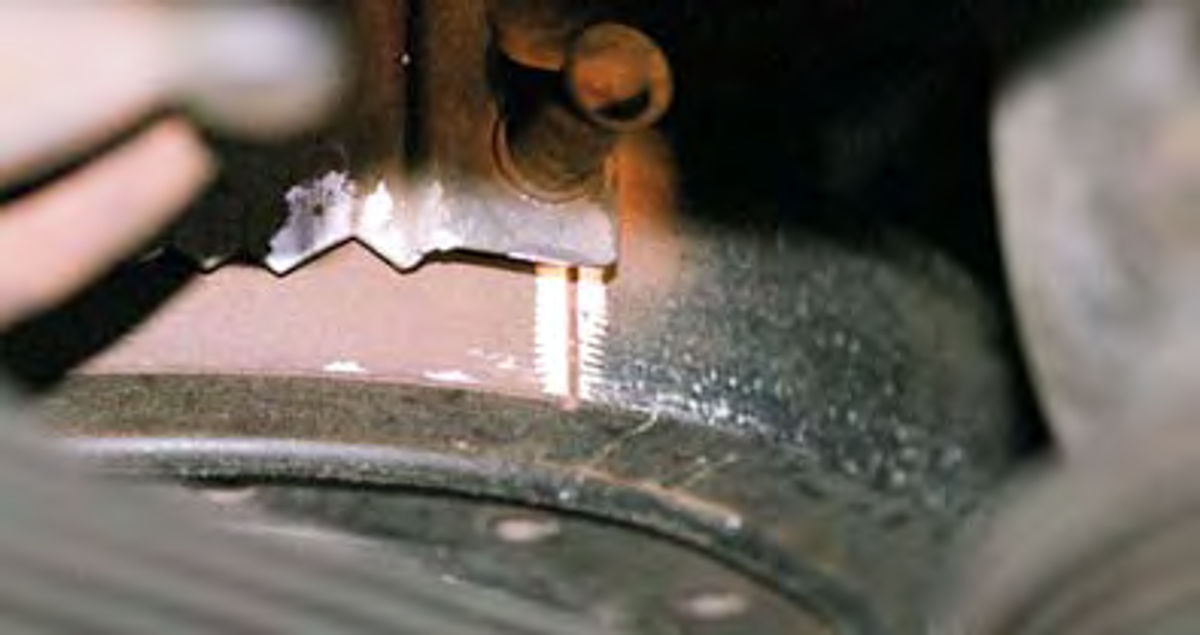Milt’s Tune-Up Advice
The owner complained: “this truck misses at idle.” In addition, “it idles kind’a rough.”
It starts up from cold “just fine,” passes smog (road load dyno test in California), and runs great on the freeway. “It pings slightly during light acceleration.”
This ’89 Chevrolet truck had just been “tuned-up,” receiving new spark plugs, new plug wires, and a new distributor.
This truck is equipped with a 350 CID engine, throttle body injection (TBI), exhaust gas recirculation (EGR), and a single wire (non-heated) oxygen sensor. The odometer showed 79,000 miles.
Our Approach
A re-check of the tune-up included cranking performance, computer ground voltage, spark plug inspection, base timing, total advance, injector flow, TBI base gas- ket leak check, EGR flow and PCV flow.
After all tune-up items were serviced, a scan check was performed to verify the computer system displays were normal.
The Tune-up Re-check
Cranking Tests: Battery rest voltage (before cranking) measured 12.6 (full charge). During cranking the battery volt- age measured 10.8 volts. The starter ground voltage measured 0.2 volts.
The starter sounded energetic like the engine wanted to start.
Computer Ground: Why are we doing this check? The computer ground and oxygen sensor ground is located at the thermostat housing stud on this ’89 Chevy 350 TBI truck. It corrodes with age and mileage causing computer sys- tem problems, and should be checked at every tune-up.
With the key on, the computer ground voltage measured 0.05 volts at the coolant sensor ground terminal. A mea- surement less than 0.10 volts is accept- able. This checks all the computer circuits from the sensors, through the computer, to the thermostat ground con- nection, and on to the battery ground.

How to measure the computer ground voltage is outlined in “Tuning Up Autos and Trucks,” by Milt Webb. Spark Plugs: The new spark plugs, installed during the previous tune-up, were removed and inspected. Number 5 was loose. Number 7 was cracked on the outer porcelain surface. (See Photo 1.) Number 8 had a dark spot on the inner porcelain surface. This indicates a slight burning of oil. All plugs were gapped at 0.035 inches (specification). The number 7, cracked spark plug, was replaced.
Engine Checks: In my experience #8 and sometimes #6 spark plugs in a Chevy 350 engine may show signs of burning oil. This can be caused by the bottom side of the intake manifold gasket suck- ing air (and some oil and blow-by) into cylinders 6 and 8. In addition, the intake manifold may be cracked and sucking the oil out of the “valley” and into cylin- ders 6 and 8.
To test for these conditions remove the oil fill cap, block off the PCV valve, and attach the PCV tube to the air cleaner. Then start the engine.
At idle, squirt starter fluid into the oil fill cap hole momentarily. If the engine RPM speeds up, the intake manifold gasket may be leaking air on the bottom edge, or the intake manifold may be cracked.
If this is the leak source, the oil burn- ing condition may increase, leading to spark plug fouling.
Base Timing: The distributor had been replaced during the prior tune-up. On this TBI Chevy Truck the under-hood emission and tune-up label clearly states to “disconnect the tan-black wire” located up on the top right of the firewall, behind the wiring junction cover. The base timing is specified at 0° with the tan-black wire disconnected.
Timing Marks: The timing marks on this truck are very clear.

The timing plate was cleaned with sol- vent and marked at the large V in the timing plate which is 0° (TDC). The damper was marked at the slot, which is TDC on the number 1 cylinder. Always clean and mark the plate and slot with chalk or paint. You don’t want to be guessing when checking the base tim- ing. (See Photo 2.)
The base timing was at 3° BTC with the tan-black wire disconnected. The base timing was readjusted to 0° (TDC). Maladjustment on base timing can cause pinging, one of the owner’s concerns.
Total Advance: With the tan-black wire reconnected, restart the engine and mea- sure the idle advance with an adjustable timing light.
Our case history truck measured 18° BTC at idle RPM. At 2500 RPM in neutral steady state, the advance was 25° BTC.
The tan-black wire is the “computer total advance” wire controlling spark plug firing through the ignition module in the distributor.
The “total advance” test just described proves the computer is “doin’ its thing.”
















